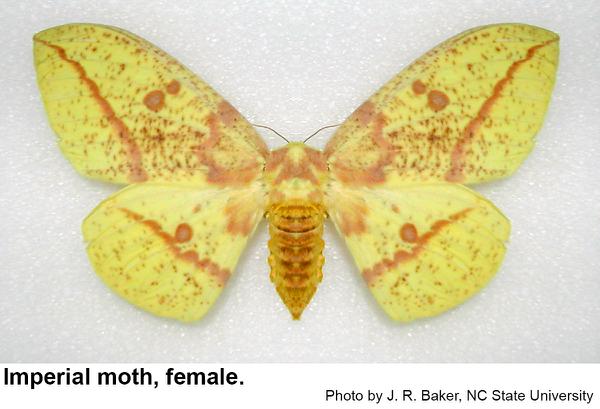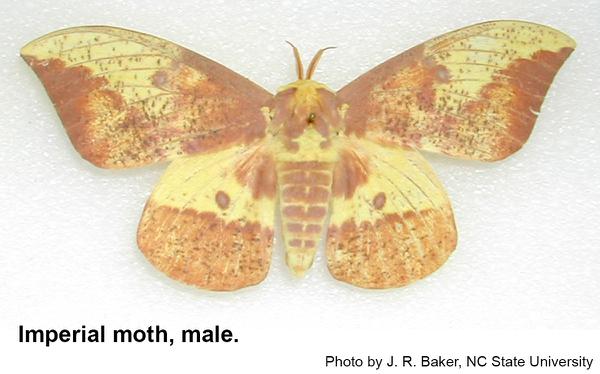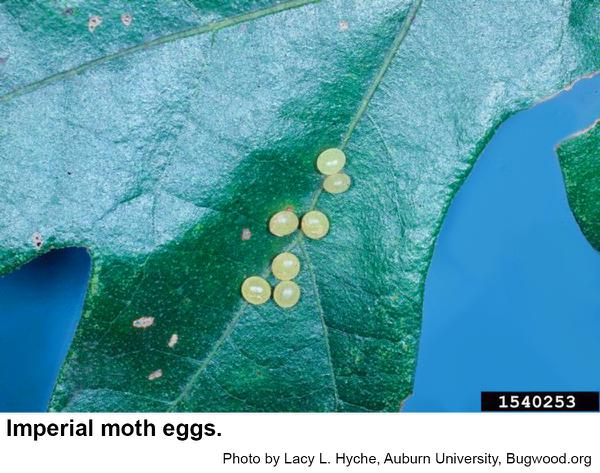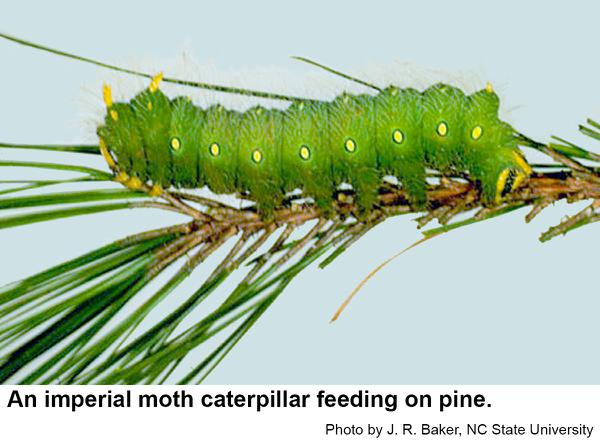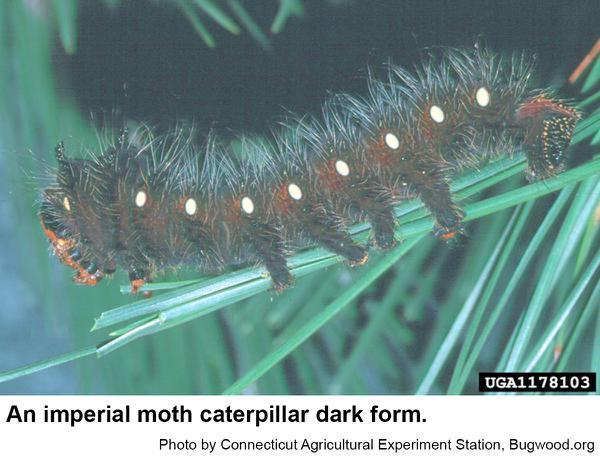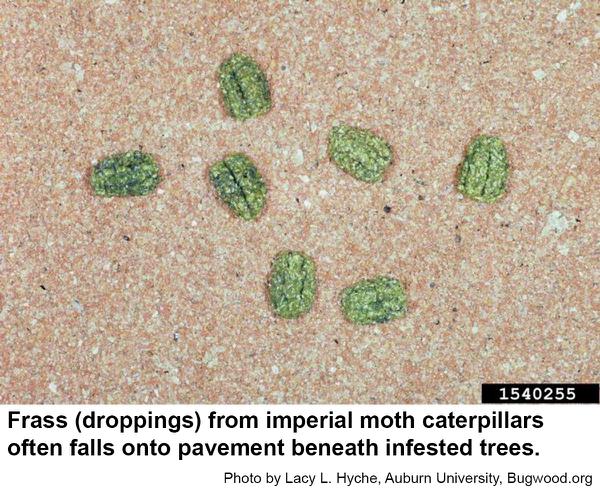Description and Biology
Imperial moths, Eacles imperialis, are large, mostly yellow moths with spots, lines and splotches of light to dark brown. They are classified in a section of the giant silkworm family called the royal moths. In late spring, Imperial moths emerge from the soil, mate, and females lay hundreds of eggs on a wide variety of trees. The eggs are flattened spheres almost 1/8 inch across. From the eggs hatch orange caterpillars almost half inch long with conspicuous black spines. Caterpillars eventually develop into large, fat, green to brown to almost black worms three to 5 inches long! Some brown caterpillars may have conspicuous orange spots. Mature green caterpillars have yellow knobs on their thorax and yellow spots down each side (the spiracles through which they breath). The other color forms have dark knobs. Mature caterpillars are also covered with long, fine hair. Fully grown caterpillars crawl to the soil and dig in. They molt into a pupal stage in the soil. The pupae are reddish brown, cylindrical, and taper slightly toward the rear. There is a small, forked structure at the tip end. The pupae evidently use that structure to help dig up to the soil surface. It is generally thought that a second generation of moths emerges from the pupal stage sometime later in the summer. These females mate and lay eggs for the next generation of caterpillars. When fully grown, they dig into soil to pupate and spend the winter in soil. Moths emerge from the overwintering pupae the following spring. However, there is some uncertainty whether we have two generations per year in North Carolina or one. Some overwintering pupae may delay development until well into the summer giving the appearance of a second generation of moths. Certainly further north only one generation occurs.
Host Plants
Imperial moth caterpillars can feed on dozens of kinds of trees but seem to prefer pines, oaks, maples, sassafras, and sweetgum. Cedar, elm, persimmon, hickory, beech, honeylocust and cypress are other less common hosts as well as a slew of other plants.
Residential Recommendations
Because imperial moth caterpillars are usually rare, the only noticeable sign of an infestation may be pellets of frass that fall to the pavement under an infested trees. Each female moth lays hundreds of eggs. A logical question would be, why are the moths not more common? Evidently the caterpillars are delicious to birds. Caterpillars that feed in an exposed position on foliage are ready targets for predators. In addition, many kinds of parasites and diseases plague caterpillars. So a mother moth is lucky, indeed, if two daughters of the hundreds of her offspring survive to produce grandchildren. Because imperial moth caterpillars are usually rare, it seems a pity to use an insecticide for their management. However, they are susceptible to most of the insecticides labeled for home landscape use, should the need arise.
References
- Butterflies and Moths. Mitchell, R. T. and H. S. Zim. 2001 (revised and updated). A Golden Guide from St. Martin's Press, Butterflies and Moths.
- Common name: imperial moth, scientific name: Eacles imperialis imperialis (Drury, 1773) (Insecta: Lepidoptera: Saturniidae: Ceratocampinae). Hall, D. W. 2014. Featured Creatures, Entomology & Nematology, FDACS/DPI, EDIS, Publication Number: EENY-602.
- Life history of the Imperial Moth Eacles imperialis (Drury) (Saturniidae: Ceratocampinae) in New England, U.S.A.: distribution, decline, and nutritional ecology of a relictual islandic population. Goldstein, P. Z. 2003. Journal of Research on the Lepidoptera. 42:34-49.
- Extension Plant Pathology Publications and Factsheets
- Horticultural Science Publications
- North Carolina Agricultural Chemicals Manual
For assistance with a specific problem, contact your local Cooperative Extension Center.
This Factsheet has not been peer reviewed.
Publication date: Feb. 9, 2017
Reviewed/Revised: Sept. 24, 2019
Recommendations for the use of agricultural chemicals are included in this publication as a convenience to the reader. The use of brand names and any mention or listing of commercial products or services in this publication does not imply endorsement by NC State University or N.C. A&T State University nor discrimination against similar products or services not mentioned. Individuals who use agricultural chemicals are responsible for ensuring that the intended use complies with current regulations and conforms to the product label. Be sure to obtain current information about usage regulations and examine a current product label before applying any chemical. For assistance, contact your local N.C. Cooperative Extension county center.
N.C. Cooperative Extension prohibits discrimination and harassment regardless of age, color, disability, family and marital status, gender identity, national origin, political beliefs, race, religion, sex (including pregnancy), sexual orientation and veteran status.

